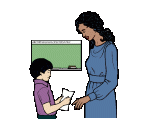There are many complex disorders that involve negative affects in children, and that severely interfere with their daily functioning at school. These disorders have to be dealt with by educators and administrators. Every child has the right to a public  education, regardless of their ability to respect authority and functionality. Although this makes classroom management a challenge, at the same time, a child is often shaped by his or her home environment and the values instilled in the child. Behaviours bear a strong influence on children’s psyche. They learn what the live.
education, regardless of their ability to respect authority and functionality. Although this makes classroom management a challenge, at the same time, a child is often shaped by his or her home environment and the values instilled in the child. Behaviours bear a strong influence on children’s psyche. They learn what the live.
Not all children develop psychological difficulties based strictly on family values. Research has proven that many childhood disorders are a result of genetics, and in some cases, influenced by hor monal abnormalities during pregnancy. Genetics are believed to cause severe personality and mental disorders in people including psychopathy and mental illness. Certainly mood disorders such as schizophrenia and bipolar affective disorder are the result of DNA. It is argued that dissociative identity disorder (DID) is a severe pathology that also has a genetic component. Whether positive or negative, a child’s personality develops in the womb. A recent New York Times article titled At-Risk From the Womb by Nicholas D. Kristof discussed numerous studies that proved mom’s emotional state weighs heavily on the child’s personality.
monal abnormalities during pregnancy. Genetics are believed to cause severe personality and mental disorders in people including psychopathy and mental illness. Certainly mood disorders such as schizophrenia and bipolar affective disorder are the result of DNA. It is argued that dissociative identity disorder (DID) is a severe pathology that also has a genetic component. Whether positive or negative, a child’s personality develops in the womb. A recent New York Times article titled At-Risk From the Womb by Nicholas D. Kristof discussed numerous studies that proved mom’s emotional state weighs heavily on the child’s personality.
Along with biological influences are what is known as “womb impression.” It is argued (although not scientifically proven) that a fetus experiences the mental, emotional and physical experiences of its mother. We know that a mother’s diet affects the fetus; this argument poses that the external environment contributes significantly to the fetus’ emotional development long before birth. This perspective is argued from scientific and spiritual viewpoints. The site Cosmic Cra dle: Souls Waiting in the Wings for Birth states: the foundation of human character is laid in the womb, through the pregnancy tenure…Ancient and traditional cultures have pregnancy and childbirth practices that are more humane and enlightened than those in modern society. Parents are consciously aware that their behaviors influence their child’s development from conceiving a baby through its pre- and postnatal development. It is an intriguing perspective however I don’t agree that all cultures and religions in modern society aren’t attuned to childbirth practices. Many mothers read aloud to their pregnant bellies. Others play music to soothe the fetus. There are many other examples of this type of conscious parenting during pregnancy in “modern society.”.
dle: Souls Waiting in the Wings for Birth states: the foundation of human character is laid in the womb, through the pregnancy tenure…Ancient and traditional cultures have pregnancy and childbirth practices that are more humane and enlightened than those in modern society. Parents are consciously aware that their behaviors influence their child’s development from conceiving a baby through its pre- and postnatal development. It is an intriguing perspective however I don’t agree that all cultures and religions in modern society aren’t attuned to childbirth practices. Many mothers read aloud to their pregnant bellies. Others play music to soothe the fetus. There are many other examples of this type of conscious parenting during pregnancy in “modern society.”.
A fascinating scientific study revealed that twins at 20 weeks’ gestationdeveloped gestures and habits that persisted into their postnatal years. In one case, a brother and sister were seen playing cheek-to-cheek on either side of the dividing membrane. At one year of age, their favorite game was to take positions on opposite sides of a curtain, and begin to laugh and giggle as they touched each other and played through the curtain. Another study claimed that mothers in low-income communities suffered more anxiety, depression, chemicals and toxins from car exhaust than women in higher income areas. The poorer mothers were likely to drink or smoke and less likely to take vitamin supplements, eat healthy food and get meticulous pre-natal care. This resulted in children born at a disadvantage, including lower educational attai nment, lower incomes and worse health.
nment, lower incomes and worse health.
School Board/School Legal Responsibilities Under the Ontario Education Act:
- Suggest a pediatric or psychological assessment to parents
- Regardless of a diagnosis, school boards permit a behavioral independent education plan (IEP) that provides teachers and behavioural students with alternatives concerning behaviours and consequences. For instance, when a child acts out against a peer, the teacher responds with a technique that assists the child in getting his behaviour under control. This is an alternative to punishment or negative consequences.
- Modified school and classroom programming, which normally do not require an IEP. For instance, a child may have a modified schedule where she attends school only for half days. Or a child may be provided with a teacher assistant, such as an educational resource worker (ERW), who as
 sists the child in controlling aggressive behaviours.
sists the child in controlling aggressive behaviours. - Annual meeting with the IPRC , Identification, Placement and Review Committee, to review the child’s IEP and determine if the need for the latter is still present, and/or needs to be altered. All schools must have IPRCs. All schools must meet annually to discuss every child’s ongoing IEP and secure ongoing funding as required. The IPRC establishes the need for funding for children who have been recently diagnosed with a learning disability and have been provided with an IEP.
Many Ontario schools have a sophisticated special education department that:
- employs several special education specialists who have completed special education specialization through additional qualifications at an accredited university. At one time, a te
 acher with special education part I or II of the program was accepted into the special education department of a school, but this is no longer practiced.
acher with special education part I or II of the program was accepted into the special education department of a school, but this is no longer practiced. - adheres to the Education Act laws and requirements and applies the laws accordingly
- works in progressive stages of a child’s academic and behavioural progress, including ongoing programming
- provides ongoing testing of children in regard to literacy and numeracy ability, plus other comprehension issues
- involves assessment and involvement with special education consultants, educational psychologists and social workers who are recruited by the school board
- practices withdrawal and inclusion in the classroom to provide special programming to children
- promotes classroom inclusion by assigning teacher aides wherever possible to assist children with their programs
- regular communication with parents, including inviting them to IPRC and special education departmental meetings and interviews
- providing intervention as early as possible
Children’s Disorders Noted in Early Childhood Years
Oppositional Defiance Disorder – ODD
This is a complex disorder involving continual opposition to authority figures, peers, and parents. Ultimately ODD may lead to aggressive and violent behaviours, in which case it is believed to be comor bid with Conduct Disorder (CD). In children with ODD, there is an ongoing pattern of uncooperative, defiant, and hostile behavior toward authority figures that seriously interferes with the youngster’s day to day functioning. A child presenting with ODD symptoms should have a comprehensive evaluation. Other disorders which may be present include attention-deficit hyperactivity disorder (ADHD), learning disabilities, mood disorders (depression, bipolar disorder) and anxiety disorders. Some children with ODD may go on to develop conduct disorder, a more severe form of ODD.
bid with Conduct Disorder (CD). In children with ODD, there is an ongoing pattern of uncooperative, defiant, and hostile behavior toward authority figures that seriously interferes with the youngster’s day to day functioning. A child presenting with ODD symptoms should have a comprehensive evaluation. Other disorders which may be present include attention-deficit hyperactivity disorder (ADHD), learning disabilities, mood disorders (depression, bipolar disorder) and anxiety disorders. Some children with ODD may go on to develop conduct disorder, a more severe form of ODD.
Conduct Disorder – CD
Conduct disorder is a repetitive and persistent pa ttern of behavior in children and adolescents in which the rights of others or basic social rules are violated. When comorbid with ADHD, CD is considered to be a predecessor to psychopathy. CD involves aggressive behavior that causes or threatens harm to other people or animals, such as bullying or intimidating others, initiating physical fights, or being physically cruel to animals. Many youth with conduct disorder may have trouble feeling empathy and reading social cues.
ttern of behavior in children and adolescents in which the rights of others or basic social rules are violated. When comorbid with ADHD, CD is considered to be a predecessor to psychopathy. CD involves aggressive behavior that causes or threatens harm to other people or animals, such as bullying or intimidating others, initiating physical fights, or being physically cruel to animals. Many youth with conduct disorder may have trouble feeling empathy and reading social cues.
Anti-Social Personality Disorder (APD)
Technically children under 18 are not diagnosed with APD, however CD that is comorbid with ADHD is believed to be a strong indicator that APD will be diagnosed in adulthood. A person aged 18 ye ars or older with a childhood history of disregard for the rights of others can be diagnosed as having APD. In order to meet DSM-IV-TR criteria for APD, a person must also have had some symptoms of conduct disorder before age 15. Studies of adopted children indicate that both genetic and environmental factors influence the development of APD. Both biological and adopted children of people diagnosed with the disorder have an increased risk of developing it. Children born to parents diagnosed with APD but adopted into other families resemble their biological more than their adoptive parents. The environment of the adoptive home, however, may lower the child’s risk of developing APD. APD usually follows a chronic and unremitting course from childhood or early adolescence into adult life. The impulsiveness that characterizes the disorder often leads to a jail sentence or an early death through accident, homicide or suicide.
ars or older with a childhood history of disregard for the rights of others can be diagnosed as having APD. In order to meet DSM-IV-TR criteria for APD, a person must also have had some symptoms of conduct disorder before age 15. Studies of adopted children indicate that both genetic and environmental factors influence the development of APD. Both biological and adopted children of people diagnosed with the disorder have an increased risk of developing it. Children born to parents diagnosed with APD but adopted into other families resemble their biological more than their adoptive parents. The environment of the adoptive home, however, may lower the child’s risk of developing APD. APD usually follows a chronic and unremitting course from childhood or early adolescence into adult life. The impulsiveness that characterizes the disorder often leads to a jail sentence or an early death through accident, homicide or suicide.
Anxiety Disorders
ADs are t he most common mental illnessesamong youngsters today, with prevalence rates ranging between 10% and 20%. Children with anxiety disorders are more likely to
he most common mental illnessesamong youngsters today, with prevalence rates ranging between 10% and 20%. Children with anxiety disorders are more likely to
develop anxiety disorders in adulthood, and have an increased risk of developing major depression, attempting suicide, and being hospitalized for mental illnesses. One particular type of anxiety disorder, Obsessive-Compulsive Disorder is found in about .5% to 2% of children and adolescents.
Developmental Coordination Disorder
DCD, also known as Developmental Dspraxia, is interruption in gross and fine motor functions. It has been called clumsy child syndrome, clumsiness, developmental disorder of motor function, and congenital maladroitness. Children with developmental coordination disorder often have d ifficulty performing tasks that involve both large and small muscles, including forming letters when they write, throwing or catching balls, and fastening buttons. They develop normally in other ways, however, they experience social or academic problems. Because of their underdeveloped coordination, they may not participate in activities on the playground. This leads to rejection by peers. Also, children who have problems forming letters when they write by hand, or drawing pictures, may become discouraged and give up academic or artistic pursuits even though they have normal intelligence. There are no known causes of developmental coordination disorders but there theories about its causes. Some attribute the disorder to biological causes. Some of the possible causes include prenatal complications as fetal malnutrition.
ifficulty performing tasks that involve both large and small muscles, including forming letters when they write, throwing or catching balls, and fastening buttons. They develop normally in other ways, however, they experience social or academic problems. Because of their underdeveloped coordination, they may not participate in activities on the playground. This leads to rejection by peers. Also, children who have problems forming letters when they write by hand, or drawing pictures, may become discouraged and give up academic or artistic pursuits even though they have normal intelligence. There are no known causes of developmental coordination disorders but there theories about its causes. Some attribute the disorder to biological causes. Some of the possible causes include prenatal complications as fetal malnutrition.
Expressive Language Disorder
Children with Expressive Language Disorder have difficulties with speech and vocabulary and have word finding problems. As a result, they speak using simplified sentences. disorder. There are two types of expressive language disorder: the developmental and acquired. Developmental expressive language disorder does not have a known cause and generally appears at the time a child is learning to talk. Acquired expressive language disorder is caused by damage to the brain. It occurs after stroke or traumatic head injury. There is no known cause of developmental expressive language disorder. The child has problems putting sentences together, using proper grammar, and recalling appropriate word use. A child with expressive language disorder is unable to communicate thoughts, needs, or wants at the same level as his or her peers. The child has a smaller vocabulary than her peers. Some children do not properly use pronouns, or leave out functional words such as “is” or “the.” Others cannot recall words to use in the sentence and substitute general words such as “thing” or “stuff.” Some children can’t organize sentences so they are easy to understand.
Developmental expressive language disorder does not have a known cause and generally appears at the time a child is learning to talk. Acquired expressive language disorder is caused by damage to the brain. It occurs after stroke or traumatic head injury. There is no known cause of developmental expressive language disorder. The child has problems putting sentences together, using proper grammar, and recalling appropriate word use. A child with expressive language disorder is unable to communicate thoughts, needs, or wants at the same level as his or her peers. The child has a smaller vocabulary than her peers. Some children do not properly use pronouns, or leave out functional words such as “is” or “the.” Others cannot recall words to use in the sentence and substitute general words such as “thing” or “stuff.” Some children can’t organize sentences so they are easy to understand.
Pervasive Developmental Disorder – PDDs
The term “pervasive developmental disorders,” also called PDDs, refers to a group of conditions that involve delays in the development of many basic skills, most notably the ability to socialize with others, to communicate, and to use imagination. Children with these conditions often are confused in their thinking and generally have problems understanding the world aroun d them. These conditions are identified in children around 3 years of age, yet the condition begins far earlier. Parents often do not notice a problem until the child is a toddler who is not walking, talking, or developing as well as other children of the same age. Sometimes parents notice differences in infancy. There are five types of pervasive development disorders: autism, aspergers, child disintegrative development, Rett’s syndrome, PDD – NOS (not otherwise specified). The use of the word “pervasive” to describe these illnesses is somewhat misleading. The definition of pervasive is “to be present throughout,” but children with PDDs do not have problems in all areas of functioning. Many children with PDDs have specific problem areas and function very well in other areas.
d them. These conditions are identified in children around 3 years of age, yet the condition begins far earlier. Parents often do not notice a problem until the child is a toddler who is not walking, talking, or developing as well as other children of the same age. Sometimes parents notice differences in infancy. There are five types of pervasive development disorders: autism, aspergers, child disintegrative development, Rett’s syndrome, PDD – NOS (not otherwise specified). The use of the word “pervasive” to describe these illnesses is somewhat misleading. The definition of pervasive is “to be present throughout,” but children with PDDs do not have problems in all areas of functioning. Many children with PDDs have specific problem areas and function very well in other areas.
Whatever the nature of children’s disorders or illnesses, seeking professional treatment at
the earliest possible time is essential. Early intervention for children’s
symptoms usually reduce the impact on further development.
Untreated symptoms can snowball and lead to the development of sometimes severe
secondary problems such as social, academic and occupational difficulties,
addictions, poor self-esteem, suicide attempts, self-harm (cutting or burning
oneself). It is important for parents to maintain a close relationship with the child’s educators and counselors. Staying involved helps ensure a child stays on track in school. Talking with the school psychologist or social worker may help to find community agencies that address the disorder. Online associations may also be helpful, so long as their legitimacy is verified.








